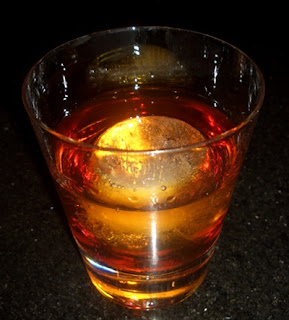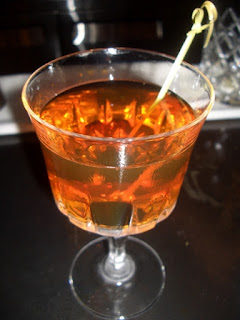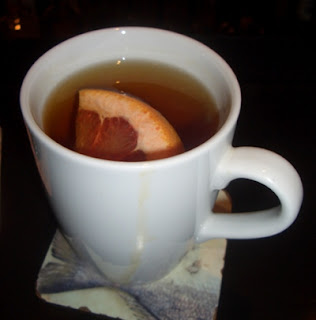Just like last year, I will finish my trilogy of year end wrap ups by revisiting all of the recipes we tried at our home bar this year. While I did create a few recipes this year, I will tack some of my favorite ones at the end and keep this list solely to recipes created by bartenders, living and deceased, from around the world.
 January:
January: From the Secret Sherry Society's contest, Owen Thomson's
Highland Games gets the nod for the best drink of the month. For runner's up, I picked the
Teresa for its elegant and quirky balance and Jabriel Donohue's
Pantorium for its Last Word-like style with one of the better names of the year (it is on the sweeter side though).
February: Mike Ryan's
Shadyside Fizz from
Beta Cocktails was intriguing enough to get my attention for February. For runners up,
The Flowing Bowl's
Iced Punch and Frank Cisneros'
Farmers Armagnac had some classic stylings.
March: From the
Big Bartenders Book, Jamie Boudrea's
Novara delightfully paired Campari and passion fruit syrup against the crispness of lemon. For runners up, the Scotch and ginger
Strange Acquaintance and the Bourbon and port
Coffee Brown were definitely solid drinks in March.
 April:
April: Leo Engel's 1878 embittered Sidecar, the
Alabazam, was a surprising favorite. Runners up were the strawberry and pastis Negroni,
Sbagliato Grosso from
Left Coast Libations, and the rather intense
Nuclear Daiquri.
May: With split spirits and split liqueurs balanced by lemon,
Café Royal's
Lilac Domino was an impressive showing that coincided well with the Spring flowers. For runners up, there were the guava-laden Jerry Thomas
Barbadoes Punch and the convergent evolution of the
Rattlesnake Fizz from
A Taste of Absinthe.
June: Easy to overlook in the 1972 Trader Vic, the
White Witch with chocolate, orange, and funky rum notes made for a great Fizz. The silver and bronze medal were the dark rum and spice
Horse Tonic and Phil Ward's tequila-based Brooklyn, the
Rojo Bianco.
 July:
July: 1022 South's modern take on the Grasshopper, namely
The Grasshoper Lies Heavy, and Martin Cate's pisco and rum Tiki drink,
Lingua Franca were the joint winners for July.
August: The early 20th century sherry, vermouth, Fernet, and Chartreuse
Meditation impressed me as something early 21th century. For runners up, I picked the tequila and herbal
Under the Volcano from
Beta Cocktails and Joaquin Simo's classically styled aperitif
Flor de Jerez.
September: The embittered and dry Martinez-like
Marliave's Cocktail from
Louis Mixed Drinks from 1906 moved me. David Shenaut's quirky
Learning to Tie and the split Old Tom, split grape mezcal drink, Nicholas Jarrett's
Black Cat scored secondary honors.
 October:
October: Jim Romdall's
Seersucker Fizz surprised me perhaps due to the Punt e Mes complexity and apricot liqueur notes. Phil Ward's flowery absinthe and tequila
Amore Morado and the 1937
Bluebeard's Passion which taught me that blue drinks are not necessarily lame received notable mentions.
November: Chicago's Sable's
Board of Directors was a surprisingly good lighter style herbal number. For runners up, I point to the Fernet Apple Jackrabbit, the
Follow that Black Rabbit, and Jason Schiffer's autumnal
Michigander.
December: William Schmidt's 19th century Martinez-like
Angelus when made with Ransom's Old Tom Gin was exquisite. Both the tropical Manhattan, the
Martinique, and Tim Lacy's beer-lightened Fizz,
Felonious Monk had good showings as well.
 Personal Creations:
Personal Creations:Looking back over the recipes I created in my home bar, I narrowed things down to my top 6 favorites (in chronological order). To see the others, click on the "*original" tag.
• The cachaça and Lillet version of the Cold Ruby Punch that appears in Jerry Thomas, the
Cold Emerald Punch was designed for summer drinking.
• Merging the Bamboo aperitif with the Crusta, the
Bamboo Crusta retained both drink styles' charms.
• With the Fix being one of my favorite old, nearly lost drink styles, the
Barbados Fix with its Earl Grey tea syrup notes turned out well.
• With influence from the Nuclear Daiquiri, the
Bikini Atoll takes the Mai Tai to a more intense level.
• Adding to the Manhattan variations, the
Coney Island makes for a good chocolatey nightcap.
• Hybridizing the joys of the Negroni with the old school challenge of Leo Engel's Knickebein, the
Knickroni is hard to forget.



































 2 oz Siembra Azul Blanco Tequila
2 oz Siembra Azul Blanco Tequila














 The 2017 collection of 855 drink recipes, bartender tributes, and essays on hospitality from CocktailVirgin's Frederic Yarm. Available at
The 2017 collection of 855 drink recipes, bartender tributes, and essays on hospitality from CocktailVirgin's Frederic Yarm. Available at  The 2012 collection of 505 drink recipes, techniques, and Boston bar recommendations from Frederic Yarm. Available at
The 2012 collection of 505 drink recipes, techniques, and Boston bar recommendations from Frederic Yarm. Available at 



